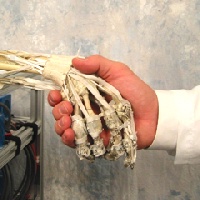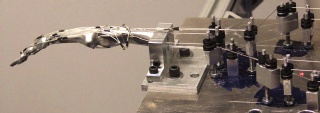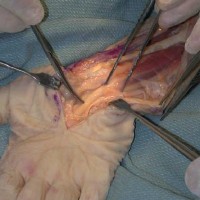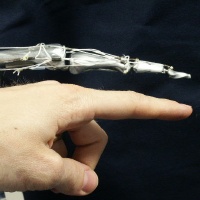Anatomically Correct Testbed (ACT) Hand

|
We are building an anatomically-correct testbed (ACT) hand to serve in three capacities:
This hand, unlike many anthropomorphic robotic hands, incorporates biomechanical aspects of the anatomy that are functionally crucial in order to use control signals that resemble the neural commands. For example, the tendon insertion points and the routing of the tendons including the extensor mechanism (an intricate web-like tendon structure that sheathes the finger) are preserved. We identified the importance of the extensor mechanisms and its ability to provide independent control of the metacarpophalangeal (MCP) joint and acts not only as an extensor but also as a flexor, abductor, adductor, or rotator depending on the finger’s posture [Wilkinson, Vande Weghe, & Matsuoka, 2003]. The bones are machined from human bone data, and are accurate in surface shape, mass, and center-of-gravity, while joints have been designed to match both degrees-of-freedom and passive stiffness. Our evaluation of the assembled index finger confirms the anatomic properties, and reveals the function of some of the peculiar shapes of the finger bones, necessity of matching the joint passive stiffness properties, and connections of the extensor mechanism [Vande Weghe, Rogers, Weissert, & Matsuoka, 2004]. |
Finally, we created an actuator that mimics both the active and passive behaviors of the human muscles. To use it as the actuator of the ACT Hand, it must conserve the tendon-driven structure so that the size or the weight of the hand do not have to be compromised. A custom-made spring composite was used to simulate the human’s nonlinear passive muscle stiffness closely (R2 = 0.99). A motor was used to siumulate the active contraction. The passive and active components interacted in parallel and they were attached to a cable tendon that inserted into the bones. In order to study the neural control of hand movements, we incorporated Hill’s model in the active contraction component. Therefore, the computer program could simply specify the muscle activation level, and the appropriate tendon tension could be provided given the current muscle length [Gialias & Matsuoka, 2004]. |
 |
past head
- Yoky Matsuoka
past staff
- Pedram Afshar
- Sean Bidic
- Nicholas Gialias
- Aaron L Greenfield
- J Michael Vandeweghe
- David D Wilkinson
past contact
- Yoky Matsuoka

